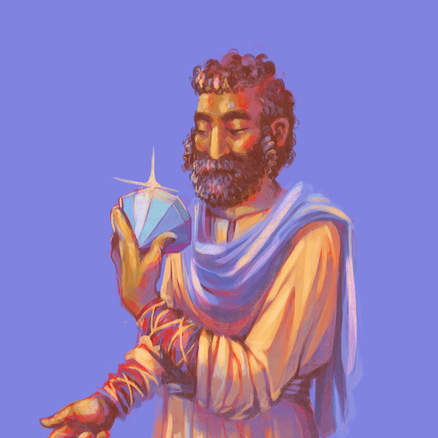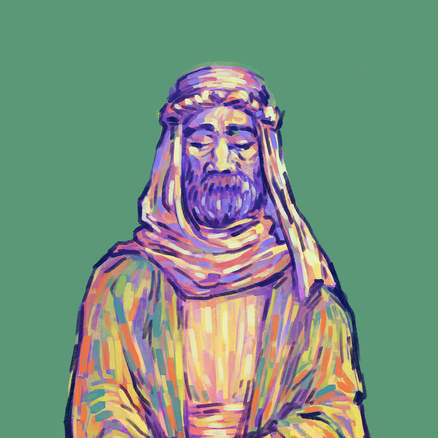
Design Patterns
See how individual stories throughout the Old and New Testaments have been beautifully coordinated through repeated words and parallel themes.
Script
Introduction [00:00-00:59]
Jon: We’ve been exploring how biblical narratives work, and it turns out stories in the BIble are like any other story. You’ve got to pay attention to the characters, the setting, and the plot.
Tim: Yeah. These are the basic tools an author uses to help readers see the meaning and significance of the events. Now it’s time to learn one final skill that will bring all of these elements together—how to detect design patterns in biblical narrative.
Jon: What do you mean by “design patterns”?
Tim: Well, the biblical authors shaped all of these elements—character, setting, and plot—to create a series of repeated patterns that weave through story after story and tie them all together. When you notice these patterns, you’ll see how different stories across the whole Bible have been coordinated to emphasize key themes.
Jon: This sounds interesting. But how do you know how to find a biblical pattern?
Tim: Well, biblical authors do it subtly. The best way to catch on is to watch them embed key words and images that link stories together. Take for example one of the main themes of the Bible, the complex and tragic human condition.
Jon: Okay.
The Temptation Pattern [01:00-03:16]
Tim: So let’s start at the beginning where God is making a really good world.
Jon: Right. Seven times it says, “God saw that it was good.”1
Tim: So those are clearly important words. Now watch. God appoints two characters named “human” and “life” to rule this world on his behalf, and they are told that everything is good for them to eat.
Jon: Except from the tree of “knowing good and evil.”2
Tim: So then the humans doubt God, and in Genesis we read that they “see that it’s good” to take this knowledge for themselves. And then we read they desire to become wise, and then finally, they take what they want.3
Jon: And everything falls apart. This story is about the human condition.
Tim: And on its own it’s a really powerful story. But the biblical authors don’t leave it there. They turn it into a pattern. It happens again with Abraham and Sarah. God brings them into the promised land, promises them a child, but they don’t trust God. They get impatient. And we read the same words. They see their Egyptian slave, they take her, and do “what is good” in their eyes. Do you get it?4
Jon: Yeah. The stories match.
Tim: Then you get to Aaron at Mount Sinai, and we read how he sees and takes the gold of the Israelites to make the golden calf. Or there’s the story about Achan who sees the gold of the Canaanites. He desires it, and he takes it for himself.5
Jon: This pattern highlights how one person’s temptation can create suffering for many people.
Tim: Exactly. It’s just like the story of Saul. We read that the Israelites see him, they desire him, and take him as their king so they can be like all the other nations.6
Jon: And Saul’s reign leads them to destruction.
Tim: Or there’s the story of David, which says that he sees Bathsheba, he desires her, and then takes her, and then kills her husband.7
Jon: And then David’s family starts destroying each other.
Tim: So you see it’s just one basic theme repeated over and over. These stories are all designed to show the temptation pattern.
Jon: Which is kind of a downer.
Tim: But the repetition builds up anticipation. Perhaps someone will come and break the pattern. This is why the stories of Jesus have been designed to carry the patterns forward to their climax.
Jon: Really?
Tim: Yeah, like what does Jesus say when he’s faced with his greatest temptation to avoid dying on the cross?
Jon: “Not my desire but your desire be done.”8
Tim: So the pattern flips. And you have one person resisting temptation, and his suffering provides life for many.
Chaotic Waters Pattern [03:17-04:52]
Jon: Very cool! Can we do one more?
Tim: Totally. How about a big one? How God brings humanity through chaotic waters into a new world. It starts on page one, where God separates these dark chaotic waters.9
Jon: Yeah. Dry land emerges as a home for the humans to flourish.
Tim: Then the pattern reappears with the chaotic waters of the flood. God rescues this remnant, Noah and his family, through the waters so they can step onto dry land and become humanity 2.0. Now does that basic storyline remind you of anything else?10
Jon: Oh right! The famous Exodus story.
Tim: Yeah! Exactly! That’s when God saves his chosen people from Egypt by leading them through the waters onto dry land.11
Jon: While Pharaoh and his army is destroyed.
Tim: The pattern repeats later with Joshua and the Israelites.
Jon: They pass through the waters of the Jordan into the promised land.12
Tim: Yeah! You got it! So now you can see how later biblical authors will project this pattern into the future. Like Isaiah, he hoped for a new Exodus with a new King leading God’s people forward into a new creation. And in this repetition, the nations become the chaotic waters.13
Jon: Ah, so you can see how combining all these patterns brings us to Jesus.
Tim: Yeah. Notice how all the Gospels highlight that story of Jesus going down to the Jordan river. He goes into the waters and back out again.
Jon: His baptism.14
Tim: That’s when God announces that Jesus is his son who will rescue the world from the chaos of our evil and violence by going into death and out the other side. This is why baptism became such a big deal for Jesus’ followers. It’s about participating in this ancient pattern of going through the waters of death and following Jesus into the new creation.15
Conclusion [04:53-05:22]
Jon: These design patterns seem really important.
Tim: Yeah. They’re actually the main way biblical authors have unified these hundreds of stories together. And every pattern develops a core theme throughout the whole biblical story that leads to Jesus.
Jon: Great. That’s biblical narrative which makes up over forty percent of the Bible. Now another thirty percent is made up of ancient poetry.
Tim: And learning to read biblical poetry is what we’ll explore in the next videos.
Related Content























